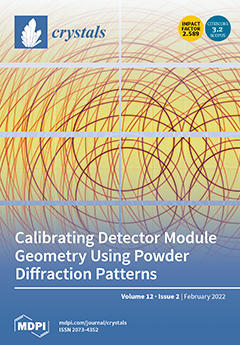The reaction of MnCl
2, 2-(5-{6-[5-(Pyrazin-2-yl)-1H-1,2,4-triazol-3-yl]pyridin-2-yl}-1H-1,2,4-triazol-3-yl)pyrazine (H
2ptptp), 4,4′-sulfonyldibenzoic acid (H
2sdba) or 4-(4-carboxyphenoxy)phthalate acid (H
3cpop) and [BMI]Br ionic liquids (BMI = 1-butyl-3-methylimidazolium) gave rise to two complexes, {[Mn
4(ptptp)
2(sdba)
2(H
2O)
2
[...] Read more.
The reaction of MnCl
2, 2-(5-{6-[5-(Pyrazin-2-yl)-1H-1,2,4-triazol-3-yl]pyridin-2-yl}-1H-1,2,4-triazol-3-yl)pyrazine (H
2ptptp), 4,4′-sulfonyldibenzoic acid (H
2sdba) or 4-(4-carboxyphenoxy)phthalate acid (H
3cpop) and [BMI]Br ionic liquids (BMI = 1-butyl-3-methylimidazolium) gave rise to two complexes, {[Mn
4(ptptp)
2(sdba)
2(H
2O)
2]·2H
2O}
n (
1) and {[Mn
3(ptptp)(cpop)Br(H
2O)
2]·2H
2O}
n (
2). The compounds have been well characterized by elemental analysis, IR spectra, thermogravimetric analysis, as well as single-crystal and powder X-ray diffraction. The structure feature of
1 is that Mn(II) ions in the [Mn
6(sdba)
2] loops of V-shaped sdba
2− ligands are ptptp
2− ligands, respectively, and a 2D layer is constructed from sdba
2− and ptptp
2− ligands. The adjacent 2D layers are connected by O–H⋯N hydrogen bonds to form a 3D supramolecular network. The neighbouring trinuclear Mn(II) clusters in
2 are linked by V-shaped cpop
3− ligands to give a 2D layer, which is penetrated by ptptp
2− ligands to form self-threading structure. The results of variable-temperature magnetic studies have shown that the magnetic interactions between the Mn(II) ions in
1 and
2 are mainly due to antiferromagnetic coupling.
Full article





